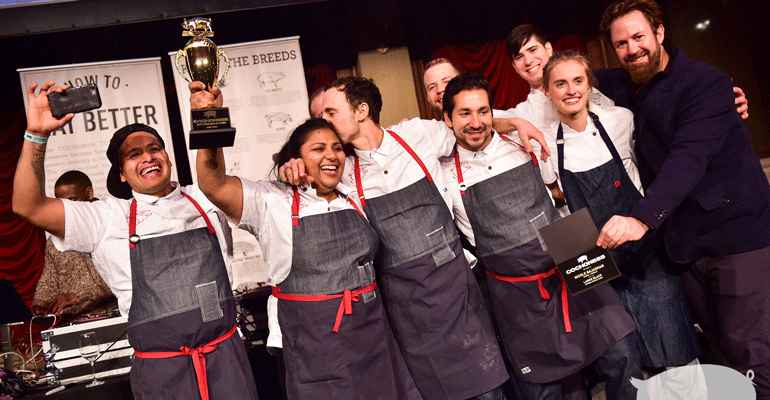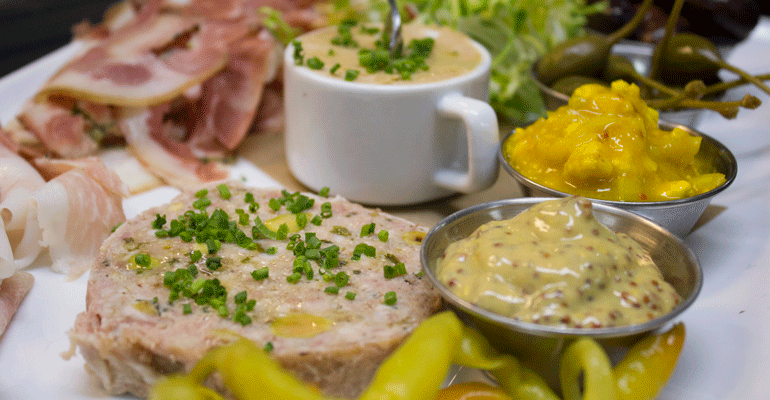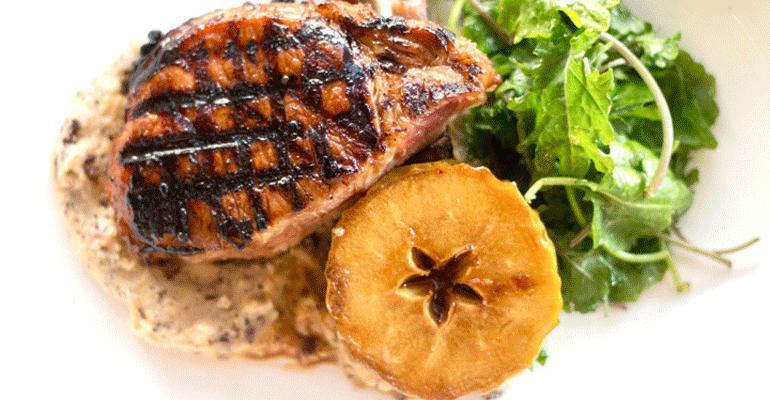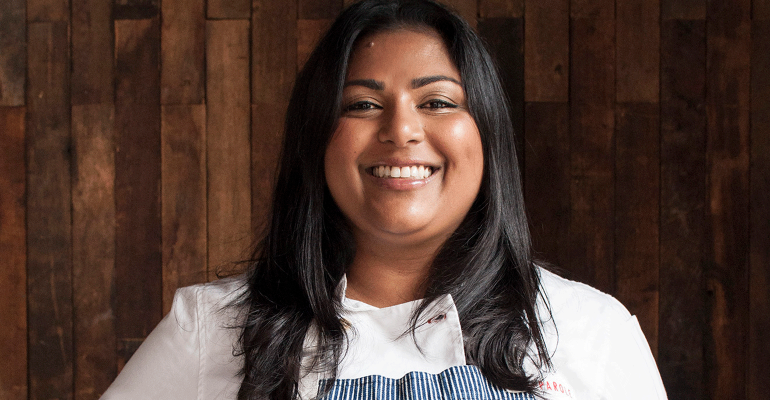Nicole Gajadhar, chef de cuisine at Saxon and Parole in New York City, is among a select group of women who have carved out a space for themselves as butchers in what has historically been an all-male profession.
At Saxon and Parole, Gajadhar isn’t breaking down whole hogs and creating nose-to-tail charcuterie just to make a bold statement; she’s doing it out of a sincere appreciation for well-raised animals and a love of good pork.
According to the Bureau of Labor Statistics, 1,950 individuals were employed as butchers or meat cutters in restaurants in 2017, about .02 percent of total industry employees. Of individuals working full-time as butchers or meat cutters in total only about a quarter are women, according to the latest research from The National Women’s Law Center.

Gajadhar and her team after winning Cochon555 in 2017
Below, Gajadhar, who was crowned “Princess of Pork” after winning the Cochon555 2017 culinary competition, shares her pork sourcing and preparation tips, her experience as an immigrant and a woman of color in a largely white-male-dominated profession, and more.
How do you use pork in Saxon and Parole’s charcuterie board?
We literally use pork in every part of our charcuterie board, from the nose to the tail. We have items on the board that are tried-and-true classics at Saxon, such as the Country Pork Terrine and the Pork Rillette. With the head we make Porchetta di Testa, which is cured, rolled, packed with herbs, and then [cooked] sous vide. We also have a honey-lavender ham that’s cured for two weeks then smoked and roasted. It’s cured with loads of spiced aromas: juniper berries, peppercorns, herbs de Provence and lavender. Overall, I love to keep the classics consistent, but rotate around two or three pieces per quarter to keep our offerings seasonal.
What do you look for in good pork?
Visually, I look for a nice pinkish-reddish hue, great marbling, specks of fat and firm to the touch. Most folks are used to light pale to white meat, but when you’re sourcing true heritage breeds and taste the dark richness of its meat, it reminds you of what pork should truly taste like.

Gajadhar's Meat, Cheese and Pickles plate on the menu at Saxon and Parole
How has sourcing of pork changed since you first began working in butchery?
There is a higher demand for more inexpensive products and that demand has manifested into livestock being mass produced making it difficult to buy and source high-quality products. But there are still some great producers out there that are really excelling at raising quality animals and hitting some major points of my checklist as a chef —breed, feed, flavor profile, farmer’s vision/techniques.
What is your favorite breed of pig?
The different breeds offer different opportunities for applications in food depending on their fat content, size and flavor profile, etc. However, I do like heritage breed blends. Sometimes you get the best features and flavors from blended pigs. It makes it easier to use in different applications and preparations at the restaurant. Our pork chop on the menu is a blended breed of Berkshire and Doroc. I love fatty heritage breeds because they allow for a beautiful piece of meat that will be one-third fat cap. Blended breeds are also amazing to use for charcuterie because all that fat can be used to grind, cure, and render. At the restaurant, I use a blended breed with one-quarter fat cap and beautiful marbled specks that makes it more palatable and desirable for our guests. However, the Berkshire or the Gloucestershire Old Spot breed belly is amazing for our rillettes and pistachio pâté terrine.

Pork Chop, like this current preparation, is a staple on the menu at Saxon and Parole.
What’s it like being a butcher who is both female and a person of color in a largely white-male dominated profession?
I am proud to represent two minority sectors of the industry. At first, I was intimidated, but I always had the thought, ‘I can do the same job as these men or even better so why should I feel a certain way?’ I’m well trained, and I know what I’m doing so why should I feel different?
I used to work for Jonnatan Leiva [at 10 Downing and The Lion] who was the first to give me confidence as a woman in this industry. He would always have me break down the pigs for the restaurant in front of our staff. It was his way of showing everyone in the kitchen that anyone can do this job — man or woman. To this day, I remember that moment and am thankful for it.
How do your Trinidadian roots impact your cooking?
I grew up eating pork. My granddad raised pigs and many other livestock breeds. He was the first one to instill in me that nothing goes to waste and that eating and preparing a meal was a family affair. This is without a doubt one of the reasons I have such a wonderful appreciation for animals and the love that goes into raising them.
What was it like competing against all male chefs at Cochon555?
Not only was I the only female — I was an immigrant, woman of color and I loved it so much! I was competing against so many brilliant chefs, and it just gave me more of a reason to win. That day, my food expressed all that I love about my culture, for flavors old and new, as well as the appreciation for the animal that was given to me.





